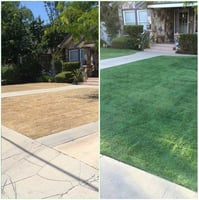Gutters play a crucial role in protecting your home from water damage by channeling rainwater away...
Plants for Ground Cover or Embankments
Discover the beauty and functionality of ground cover plants for your property's embankments with our expert guide.
Choosing the Right Ground Cover Plants

When selecting ground cover plants for your embankments or areas of bare soil, it is important to choose varieties that are well-suited to your specific needs. Consider factors such as sunlight exposure, soil type, and moisture requirements. Conifers like juniper and grasses like mini mondo are excellent options as they provide evergreen coverage and help prevent erosion.
Another important aspect to consider is the growth habit of the plants. Some ground cover plants spread quickly and fill in large areas, while others are more compact and suitable for smaller spaces. Think about the size of the embankment or area you need to cover and choose plants accordingly.
Additionally, consider the overall aesthetic you want to achieve. Some ground cover plants have vibrant foliage colors or unique textures that can add visual interest to your property.
By carefully selecting the right ground cover plants, you can create a beautiful and functional landscape that enhances the appearance of your embankments.
Planting and Maintaining Ground Cover
Once you have chosen the right ground cover plants for your embankments, it's time to start the planting process. Here are a few steps to follow for successful planting and maintenance:
1. Prepare the soil: Before planting, remove any weeds or debris from the area and loosen the soil to ensure good drainage. Adding organic matter, such as compost, can improve soil fertility and moisture retention.
2. Planting technique: Dig small holes for each plant, making sure to space them according to their mature size. Gently remove the plants from their containers and place them in the holes, backfilling with soil and firming it gently around the roots.
3. Watering: After planting, thoroughly water the ground cover plants to help them establish their root systems. Keep the soil consistently moist during the first few weeks, especially during hot or dry periods.
4. Mulching: Applying a layer of mulch around the plants can help conserve moisture, suppress weed growth, and improve the overall appearance of the embankment. Pine straw or other organic mulches are excellent choices.
5. Regular maintenance: Once established, ground cover plants generally require minimal maintenance. However, regular watering, occasional pruning to control growth, and fertilizing as needed can help keep them healthy and thriving.
By following these planting and maintenance practices, you can ensure the success of your ground cover plants and enjoy their benefits for years to come.
Enhancing Visual Appeal with Mulch or Pine Straw
In addition to providing practical benefits, mulch or pine straw can also enhance the visual appeal of your embankments. Here's how:
1. Contrast: By adding a layer of mulch or pine straw around your ground cover plants, you can create a beautiful contrast between the plants and the surrounding soil. This contrast can make the plants stand out and add visual interest to the embankment.
2. Texture: Mulch or pine straw can add texture to the landscape, creating a more dynamic and visually appealing environment. The texture of the mulch or pine straw can complement the foliage of the ground cover plants, creating a harmonious and attractive look.
3. Weed suppression: Mulch or pine straw acts as a natural weed suppressant, helping to keep unsightly weeds at bay. By preventing weed growth, the mulch or pine straw allows the ground cover plants to take center stage and maintain a neat and tidy appearance.
By incorporating mulch or pine straw into your embankments, you can not only improve the health and growth of your ground cover plants but also enhance the overall visual appeal of your property.
Essential Tools and Supplies for Successful Planting
To ensure successful planting of your ground cover plants, it's important to have the right tools and supplies on hand. Here are some essentials:
- Shovel or garden trowel: These tools are necessary for digging holes and planting the ground cover plants.
- Garden gloves: Protect your hands from dirt, thorns, or any potential irritants while working with the plants and soil.
- Watering can or hose: Proper watering is crucial for the establishment and maintenance of ground cover plants. Make sure you have a watering can or hose to provide adequate moisture.
- Mulch or pine straw: As mentioned earlier, mulch or pine straw can greatly benefit your ground cover plants. Have enough mulch or pine straw to cover the desired area.
- Pruning shears: Occasional pruning may be needed to control the growth of the ground cover plants. Pruning shears will help you trim any overgrown or damaged foliage.
By having these essential tools and supplies, you'll be well-prepared to plant and maintain your ground cover plants effectively.
Professional Assistance for Challenging Projects
While planting and maintaining ground cover plants can be a rewarding DIY project, certain situations may require professional assistance. Here are some instances when seeking help from experts like CleanYardCare LLC can be beneficial:
- Lack of tools: If you don't have the necessary tools or equipment for the project, professionals can provide the right tools and ensure efficient and accurate work.
- Limited time or physical ability: Planting and maintaining ground cover plants can be time-consuming and physically demanding, especially for larger embankments. Professionals can save you time and effort by completing the task quickly and efficiently.
- Expert advice: Professionals have extensive knowledge and experience in landscaping, including selecting the right ground cover plants for specific conditions. They can provide valuable advice and recommendations based on your property's unique needs.
By enlisting the help of professionals when needed, you can ensure that your ground cover project is completed to the highest standard, resulting in a beautiful and well-maintained landscape.



